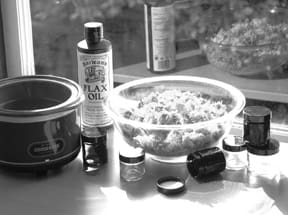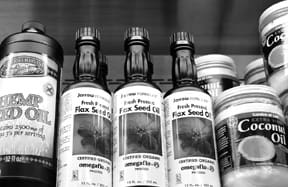Making Herbal Salves for Dogs: Overview
1. Below, learn how to make your own herb-infused oils and salves for fast, effective first-aid or protective treatments.
2. Shop for organic, cold-pressed seed or nut oils that are fresh, not rancid. Refrigerate for maximum shelf life.
3. Use carrier oils to protect wounds, speed healing, and improve skin and coat.
4. Combine carrier oils with essential oils to provide your dog with aromatherapy.
Whenever you’re blending a massage oil for your dog, diluting an essential oil, making a salve, or simply looking for ways to speed the healing of wounds or abrasions, reach for the right carrier oil.
Also called fixed oils or base oils, carrier oils literally carry or deliver essential oils or herbal ingredients where needed. Most are vegetable oils pressed from fruits, seeds, or nuts, and they contain important healing properties of their own.

The carrier oils recommended here are appropriate for use on dogs of all ages (and on humans, from infants to elders).
Any vegetable oil will work as a carrier oil, including the cheapest cooking oils in your supermarket. Those oils, usually corn or soy, will dilute essential oils, moisturize, soften the skin, and provide a layer of protection, but they are avoided by most holistic practitioners because they contain solvent and pesticide residues. In addition, because unsaturated fats deteriorate rapidly, supermarket cooking oils are highly refined to retard spoilage, which changes their chemical composition and removes nutrients. For best results, shop local health food stores or online sources for organic oils. Check for rancidity; don’t use any vegetable oil that smells “off” or spoiled.
Carrier Oils for Herbal Remedies
The three types of carrier oils are basic, additive, and infused or macerated.
Basic carrier oils can be used by themselves or with essential oils for body massage and to moisturize and protect the skin. They tend to be pale or colorless, light rather than thick, and usually have little, if any, odor.
Additive carrier oils are heavier, more expensive, thicker, and often have a pronounced odor. Most are diluted with basic oils for topical application or used full-strength on small areas.
Infused or macerated carrier oils result when plant material is added to a basic oil (usually olive or sunflower) and gently heated, then strained. The plant’s oil-soluble compounds are transferred to the carrier oil, increasing its therapeutic qualities.
A favorite infused oil is calendula, made with fresh or dried blossoms of the European marigold, Calendula officinalis. Calendula is famous for its treatment of broken veins, varicose veins, bruises, burns, inflammation, skin lesions, and other skin problems. The retail price of four fluid ounces of organic calendula carrier oil ranges from $9 to $20, but you can make your own at a fraction of that cost.
St. John’s wort blossoms (Hypericum perforatum), which produce a deep red macerated oil, and comfrey leaves (Symphytum officinale), which produce a green oil, are prized for their ability to stimulate rapid wound healing, speed recovery from burns, reduce inflammation, repair nerve tissue damage, and heal the skin. These herb-infused oils are often combined with calendula oil for use as a stand-alone oil, as a carrier for essential oils, or as a salve.
However you create them, infused oils can be applied to a dog’s cuts, wounds, burns, or abrasions, or to dry, cracked skin on the nose or paw pads. Any essential oil can be added to infused carrier oils for therapeutic purposes, usually at the rate of three to five drops essential oil per teaspoon of carrier oil, or 10 to 15 drops per tablespoon.
Occasionally, carrier oils are used to dilute essential oils that are taken orally. All of the basic oils listed here are safe for a dog to lick, especially if from organic sources. However, try to keep your dog from licking salves and oils off as soon as they are applied. If the problem is a cut or wound that threatens to become a lick granuloma, more serious preventive measures, such as an Elizabethan collar, may be needed. For optimal healing, wounds should be treated, then left undisturbed for as long as possible.
Calendula Carrier Oil Recipe:
To make this infused or macerated oil, start with one quart or one liter of organic olive oil or a blend of olive and other oils, such as equal parts olive and jojoba, sunflower, safflower, or sweet almond oil, or use any basic oil or blend of oils.
If you have access to fresh calendula, which is easy to grow in sunny locations, infuse its orange or yellow blossoms just after picking. Bulk herb suppliers sell dried calendula, and some herb farms or herbal supply companies sell fresh blossoms in season.
In the top of a double boiler that has water in the lower pan, combine one quart oil and eight ounces (by weight) of fresh calendula blossoms or four ounces (by weight) of dried calendula. Cover the upper pan and bring the lower pan to a simmer.
Alternatively, loosely fill a glass canning jar with fresh or dried calendula blossoms, then fill the jar with oil to about an inch from the top. Wipe the rim to be sure it is clean and dry, then close the lid. Place the jar on a rack in a pot of hot water and bring the water to a slow simmer. For best results, use a pot large enough for water to surround the jar.
Or simply combine oil and blossoms in a ceramic slow cooker set to low heat. If making a small batch (less than one quart), use the “keep warm” setting and extend heating time.
Using any of these methods, let the blossoms infuse for four hours or longer. Check to be sure the oil doesn’t get hot enough to smoke or burn. The heat should be gentle. If using a double boiler or glass jar, replenish simmering water as needed. Infusing for 12 to 24 hours produces a deeper yellow/orange color. Turn heat off and let the oil stand until cool, then strain through cheesecloth. The oil will be clear and golden. Add the contents of a 400-IU liquid vitamin E capsule for each fluid ounce of oil (eight capsules per cup or 32 per quart) as a preservative.
To create a solar infusion, combine fresh or dried calendula with oil in a clean glass canning jar and leave it in hot summer sunlight as long as possible. A jar with a tightly sealed lid can be left outdoors for months, absorbing the sun’s energy. Many herbalists consider solar infusions superior to those made by other methods.
How to Make A Salve
Infused carrier oils, with or without the addition of essential oils, can be turned into salves for the treatment of wounds, skin cracks, abrasions, burns, and other injuries. Simply warm strained oil over gentle heat and add one to two ounces beeswax (available from beekeepers or herbal supply companies) to each cup of oil. Continue warming the oil until the beeswax melts.
Place a tablespoon of the salve in the freezer until it’s cool, then check the consistency. If it’s too hard, add more oil to your mix; if it’s too soft, add more beeswax. Aim for a salve that is thick but not solid. Soft salves are easy to apply without applying pressure to injuries. When the salve is perfect, pour it into small jars and label. If desired, add several drops of essential oil just before or after pouring into jars. The result will be a versatile, soothing, healing salve for human and canine use.
All About Basic Carrier Oils
All of the following can be used full-strength or combined with other oils. For best results, buy organic, cold-pressed, unrefined oils and check for spoilage before use. Most of these oils benefit from refrigeration. To use vitamin E as a natural preservative, add 400 IU liquid vitamin E to each fluid ounce of oil.
Some carrier oils and additives are especially well suited to specific conditions, helping you choose from what may seem like a bewildering assortment of possibilities. Other factors are availability and cost. Most health food stores carry several good-quality carrier oils, but their selection of special additives tends to be limited. Visit the Web sites or send for catalogs from our recommended resources (bottom of page) for additional information and recommendations.
• Almond oil (Prunus amygdalus). Also called sweet almond oil, this popular carrier oil contains protein, glucosides, minerals, and vitamins A, B1, B2, B6, and E. Almond oil is very pale yellow and has a subtle fragrance. Widely used as a massage oil because it lubricates and protects without being quickly absorbed, almond oil is recommended for skin conditions such as eczema, dryness, inflammation, muscle soreness, and itching. In addition, it helps heal burns.
• Apricot kernel oil (Prunus armeniaca). Rich in vitamin A, apricot kernel oil is pale yellow and has a light, pleasant texture. Appropriate for all skin conditions, it nourishes and helps heal sensitive, delicate, dry, inflamed, or aged skin.
• Coconut Oil (Cocos nucifera). There are three types of coconut oil: fractionated, refined (also labeled RBD, for refined, bleached, and deodorized), and virgin or unrefined.

Because fractionated and refined oils have been stripped of every possible contaminant, they have an unlimited shelf life and keep for years without refrigeration. They are also rich in lauric acid and contain saturated fats, making them more compatible with skin than most vegetable seed oils.
Fans of unrefined or virgin coconut oil consider this type superior because it contains more nutrients and is a more natural product. Unrefined coconut oils usually have a pronounced coconut fragrance, while refined and fractionated coconut oils are odorless. Unlike fractionated coconut oil, both RBD and unrefined coconut oils are solid at temperatures below 75° F, so in cold weather, they have to be warmed before application, or they can be blended with vegetable seed oils, which remain liquid.
• Emu oil. No, it’s not a vegetable oil, but emu oil (from the Australian birds that resemble ostriches) has become a popular treatment for muscle pain, sore joints, arthritis, eczema, psoriasis, hair loss, skin fungus, and other conditions. It works well as a massage oil and as a carrier oil for essential oils, has a mild fragrance, and is quickly absorbed.
• Grapeseed oil (Vitis vinifera). This colorless, odorless, light oil penetrates quickly, toning and tightening the skin. A gentle, non-greasy emollient.
• Hazelnut oil (Corylus avellana). Hazelnut oil contains protein, vitamins, minerals, oleic acid, and linoleic acid. Slightly astringent, it strengthens capillaries, stimulates circulation, and is quickly absorbed.
• Jojoba (Simmondsia californica). Technically a plant wax or ester, jojoba contains protein, minerals, and myristic acid. It closely resembles sebum, making it an excellent treatment for psoriasis, eczema, dermatitis, dandruff, and all skin and hair conditions. Jojoba is an antioxidant, which helps preserve other carrier oils in blends. It never goes rancid and does not require refrigeration.
• Olive oil (Olea europaea). The world’s most widely used carrier oil, olive oil is green in color and contains protein, minerals, and vitamins. It’s been used for thousands of years for skin and hair care, as a massage oil for rheumatic joints, and to soothe and heal wounds. But olive oil has a pronounced fragrance, and the less refined and more natural the oil, the more it smells like olives, enough to overwhelm all but the most strongly scented essential oils.
Herbalists often use olive oil to prepare herbal oil infusions (macerated oils) that are used as lotions or thickened to make salves. Olive oil is useful for all skin and hair conditions, as well as bruises, sprains, and joint inflammation.
Use it full-strength or in any dilution. Unlike most vegetable oils, olive oil does not require refrigeration or the addition of antioxidants to retard rancidity.
Squalene is a moisturizer extracted from olive oil. It is also a natural component of young skin, and its decline after adolescence contributes to the aging process. Clear and colorless, squalene looks like water. Because it both moisturizes the skin and creates a barrier that seals in moisture, squalene is an ideal ingredient for blends that treat chapped, dry, or scaly skin, eczema, or contact dermatitis. Some aromatherapy supply companies sell squalene.
• Safflower oil (Carthamus tinctorius). High in linoleic acid, protein, vitamins, and minerals, safflower oil is very light and odorless. It’s useful for all skin types and helps relieve the inflammation of painful sprains, bruises, and painful joints.
• Sesame oil (Sesamum indicum). Thick and with a strong fragrance (even stronger if you buy toasted sesame oil), this seed oil contains vitamin E, minerals, proteins, lecithin, and amino acids. It’s an effective treatment for psoriasis, eczema, rheumatism, and arthritis, and it softens the skin.
• Soy oil (Gllycine soja). Soybean oil is the most widely used vegetable oil in America’s food supply, but almost all of it is solvent-extracted from pesticide-treated plants that are genetically engineered. The exceptions are sold in health food stores and by some aromatherapy supply companies. A light oil with a mild scent, organic soy oil is suitable for all skin types.
• Sunflower oil (Helianthus annuus). High in unsaturated fatty acids and containing vitamins A, B, D, and E plus minerals, lecithin, and inulin, sunflower oil has a light texture and is easily absorbed. Beneficial for all skin types, sunflower oil is used to treat leg ulcers and skin disease, bruises, diaper rash, and cradle cap.
Not Recommended for Use As Carrier Oil:
• Mineral oil, a petrochemical by-product used in most baby oils, is not recommended for pet use or for aromatherapy. Mineral oil is a harsh laxative when taken internally (or licked and swallowed), and its large molecules interfere with the absorption of essential oils.
Add These Oils to Your Salve:
You can blend some of these with your carrier oil for added benefits. Most aromatherapists recommend that additives like those listed below make up no more than 10 to 15 percent of the carrier oil blend because of their expense, because some of them can irritate the skin or eyes when used in large quantities, or because of their consistency. All of the additive oils work very well in blends.
• Avocado oil (Persea spp.). Dark green, thick, and heavy, avocado oil is pressed from the fruit of the avocado and contains protein, vitamins, lecithin, and fatty acids. It is recommended for all skin types, especially dry, dehydrated skin, and it is often used in blends that treat eczema. Use up to 10 percent in a carrier oil blend.
• Black currant seed oil (Ribes nigrum). High in gamma linolenic acids, black currant seed oil is similar to evening primrose and borage seed oils. Use up to 10 percent in a carrier oil blend.
• Borage seed oil (Borago officinalis). Best known as a nutritional supplement for menopausal problems and heart disease, borage seed oil contains gamma linolenic acid (GLA), vitamins, and minerals. This pale yellow oil is an effective treatment for psoriasis, eczema, and aging skin. Deeply penetrating, it stimulates skin cell activity and regeneration. Use up to 10 percent in a carrier oil blend.
• Calophyllum or tamanu oil (Calophyllum inophyllum). Pressed from the fruit and seed of the tamanu tree of India and Polynesia, calophyllum oil is thick, rich, and delicately nutty or spicy. It is also one of the most prized oils for healing wounds, burns, rashes, insect bites, broken capillaries, skin cracks, eczema, psoriasis, and other skin conditions. This oil can be used full-strength but usually makes up 25 to 50 percent of carrier oil blends.
• Evening primrose oil (Oenothera biennis). Like black currant and borage seed oils, evening primrose oil is a rich source of gamma linolenic acid as well as vitamins and minerals. As a food supplement, it’s used to treat premenstrual tension, multiple sclerosis, and symptoms of menopause. As a topical oil, it treats psoriasis and eczema and speeds the healing of wounds. Use up to 10 percent in a carrier oil blend.
• Flax seed oil (Linum usitatissimum). Flax seed oil is high in essential fatty acids, vitamin E, and minerals. Although usually sold as a nutritional supplement, its topical application benefits skin, speeds wound-healing, prevents scarring, and treats eczema and psoriasis. Use 10 to 50 percent in a carrier oil blend. This is a fragile oil, so freshness and refrigeration are important.

• Kukui nut oil (Aleurites moluccana). This rapidly absorbed nut oil is high in linoleic and oleic acids, soothing skin irritations, burns, and lesions. In addition to leaving dry, rough skin feeling soft and smooth, kukui nut is said to prevent scarring when applied to wounds or abrasions. Use 5 to 10 percent in a carrier oil blend.
• Rose hip seed oil (Rosa mosquette, R. rubiginosa). Pressed from the seeds of wild roses that grow in the Andes Mountains, rose hip seed oil is reddish orange in color and rich in nutrients that regenerate damaged skin, reduce scar tissue, and help heal wounds, burns, and eczema. Use full-strength on wounds or scars; add up to 25 percent to carrier oil blends. Spoils easily; check for rancidity.
• Shea butter.Unrefined, this nut butter can be brown and smelly, but most refined shea butter is processed with hexane, which herbalists and aromatherapists try to avoid. Look for filtered shea butter (solid at room temperature), as this is a rich emollient that thickens carrier oils. Use up to 10 percent in oil blends, more in salves.
Recommended Resources for Using Aromatherapy on Dogs
Holistic Aromatherapy for Animals: A Comprehensive Guide to the Use of Essential Oils and Hydrosols with Animals by Kristen Leigh Bell (Findhorn Press, 2002).
Auroma USA, Wheaton, IL. Carrier oils.
Boston Jojoba, Boston, MA. Jojoba oil.
Florapathics Organic Living, Houston, TX. Carrier oils.
Jaffe Brothers, Valley Center, CA. Carrier oils.
Jean’s Greens, Schodack, NY. Herb-infused carrier oils, bulk herbs.
Mountain Rose Herbs, Eugene, OR. Herb-infused oils, carrier oils, herbs.
Nature’s Gift, Madison, TN. Online orders preferred. Carrier oils.
Simplers Botanicals, Sebastopol, CA. Herb-infused oils.
SunRose Aromatics, Bronx, NY. Carrier oils.






Can i use Nature’s Truth sweet almond unscented base oil with aromatherapy relaxing oil
Informative post! Thanks for sharing this wonderful post.